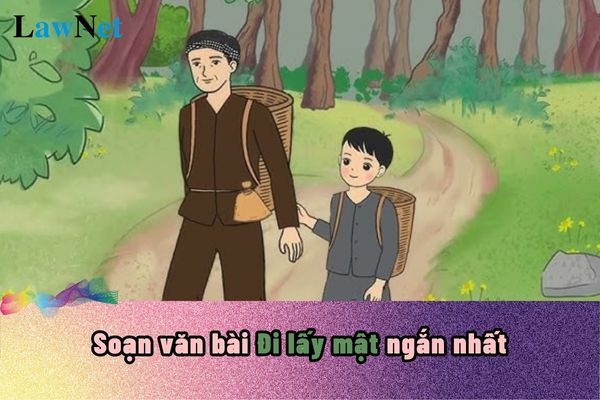Vietnam: What are the guidelines for preparing the shortest lesson “Đi lấy mật”? What are poems, folks, and proverbs to be selected for the 7th-grade Literature curriculum?
What are the guidelines for preparing the shortest lesson “Đi lấy mật” in the 7th-grade Literature curriculum in Vietnam?
The lesson “Đi lấy mật” is one of the contents that students will learn in the 7th-grade Literature curriculum.
Students can refer to the guidelines for preparing the shortest lesson “Đi lấy mật” below:
|
Shortest lesson “Đi lấy mật” *Significance of the Text |
*Note: Information about the guidelines for preparing the shortest lesson “Đi lấy mật” in the 7th-grade Literature curriculum in Vietnam is for reference only./.

Shortest lesson “Đi lấy mật”? How to Choose Poems and Proverbs in the 7th-Grade Literature Curriculum? (Image from Internet)
What are the regulations on the number of lessons for the 7th-grade Literature curriculum in Vietnam?
Under the General Education Program for Literature issued together with Circular 32/2018/TT-BGDDT, the training duration for Literature is specified as follows:
| Grade 1 | Grade 2 | Grade 3 | Grade 4 | Grade 5 | Grade 6 | Grade 7 | Grade 8 | Grade 9 | Grade 10 | Grade 11 | Grade 12 |
| 420 | 350 | 245 | 245 | 245 | 140 | 140 | 140 | 140 | 105 | 105 | 105 |
Therefore, the 7th-grade Literature curriculum in Vietnam includes 140 lessons, with 63% for reading, 22% for writing, speaking and listening 10%, and periodic assessment 5%.
What are poems, folks, and proverbs to be selected for the 7th-grade Literature curriculum in Vietnam?
Under Section 9, Appendix of the General Education Program in Literature issued with Circular 32/2018/TT-BGDDT, works that can be selected for the 7th-grade Literature curriculum in Vietnam include:
GRADE 6 AND GRADE 7
Stories, Novels
- The Last Lesson (A. Daudet)
- Green Lotus Bud (Son Tung)
- My Sister's Painting (Ta Duy Anh)
- The Little Match Girl (H. Andersen)
- Land of Southern Forests (Doan Gioi)
- The Adventures of De Men (To Hoai)
- Unexpected Events (Nguyen Nhat Anh)
- A Frog in a Well (Vietnamese Fable)
- The Flag Embroidered with Six Golden Words (Nguyen Huy Tuong)
- Hanging a Sign (Vietnamese Folk Comedy)
- The Old Man and the Goldfish (A. Puskin)
- Saint Giong (Vietnamese Legend)
- Thach Sanh (Vietnamese Fairy Tale)
- ...
Poetry, Folks, and Proverbs
- Folks about love, family feelings
- Night Scene (Ho Chi Minh)
- Poem about the Squad Without Glass (Pham Tien Duat)
- Teaching His Child (Tran Nhuan Minh)
- Journey of the Bee Swarm (Nguyen Duc Mau)
- When the Bird of Prey Calls (To Huu)
- Clouds and Waves (R. Tagore)
- Mother (Do Trung Lai)
- The Sails (Hoang Trung Thong)
- Homeland (Te Hanh)
- Son Tinh, Thuy Tinh (Nguyen Nhuoc Phap)
- Echo (Nguyen Quang Thieu)
- Vietnamese Proverbs
- Visiting Uncle Ho's Mausoleum (Vien Phuong)
- ...
Narrative proses and Prose
- The Bamboo of Vietnam (Thep Moi)
- The Leaf Domain (Do Phan)
- Co To (Nguyen Tuan)
- Love for the Homeland (I. Ehrenburg)
- A Liter of Tears (Kito Aya)
- The Man Waiting in Front of the House (Huynh Nhu Phuong)
- The Years in Elementary School (Excerpt from the Memoirs of Nguyen Hien Le)
- Deep in Hong Ngai (Tong Lam Linh)
- Missing Twelve (Vu Bang)
- I Celebrated Tet in Con Lon (Khuong Viet)
- Noon Away from Home (Tran Cu)
- ...
Argumentative Essays
- Social argumentative essay: about a phenomenon one is interested in.
- Literary argumentative essay: character analysis and work analysis.
- The Letter from the Red Indian Chief (Seattle)
- The Simplicity of Uncle Ho (Pham Van Dong)
- The Rich Beauty of the Vietnamese Language (Dang Thai Mai)
- The Patriotism of Our People (Ho Chi Minh)
- ...
Information Texts
- Texts narrating a historical event (expository).
- Texts introducing a rule or regulation in a game or activity (expository).
- Petition documents; memos, messages, emails.

